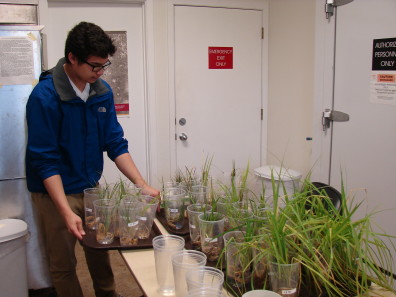Plant Pathology projects 2015
These projects relate to the detection and management of Phytophthora, a waterborne plant pathogen. We will focus on P. ramorum, the cause of Sudden Oak Death (SOD), whose long-distance spread is primarily through trade in ornamental nursery crops. There is concern about the consequences of P. ramorum establishment in WA forests. This is a quarantine organism and the projects will be done in the biocontainment lab at WSU-Puyallup.
We are also interested in the oomycete communities present in surface water bodies. Organisms such as Phytophthora, Pythium, Saprolegnia, and Phytopythium are abundant in water but little is known about most of them.
Testing wetland plants for susceptibility to P. ramorum
Constructed wetlands are being used to mitigate pollutants in agricultural runoff. These pollutants can include biological ones, such as plant pathogens. In this study we tested several wetland plants for susceptibility to P. ramorum to assess their usefulness in removing this organism from contaminated nursery runoff. Characters examined included symptom expression, asymptomatic infection, and inoculum production. Students from Pierce College did this project as an independent study class during the summer and generated some useful preliminary data.
Monitoring for invasive Phytophthora species in stormwater retention ponds
 In 2015 members of the Pierce College Biology 213 class sampled Bradley Lake at 3 different locations using various types of bait plants in order to look at the oomycete populations in the lake.
In 2015 members of the Pierce College Biology 213 class sampled Bradley Lake at 3 different locations using various types of bait plants in order to look at the oomycete populations in the lake.
In addition to Bradley Lake, students from Puyallup High School sampled two stormwater retention ponds in newly landscaped housing developments in Puyallup, as well as two locations along Clarks Creek where stormwater drains. The goal is to identify Phytophthora species that may be moving from landscaped areas into the ponds. This will help us to determine which pathogens are present on the landscape plants and allow us to detect any invasive species early. In addition, baseline information about Phytophthoras and other oomycetes in these ponds was collected.
Stream monitoring for invasive Phytophthora species on the northern Olympic Peninsula, WA
The primary goal of the project is to expand the monitoring of streams in northern Olympic Peninsula region for P. ramorum. In spring 2013 a bait sample positive for P. ramorum was collected from the Dungeness River near Sequim, WA. A second positive bait sample from this site was collected in summer 2013. Further sampling of streams in the area has not yet provided information about the source of inoculum contaminating the Dungeness. Using volunteers, this project will increase the level of monitoring activity in a high risk watershed where the pathogen is exposed to native vegetation beyond what is currently possible to accomplish by state and federal agencies, and also provide an excellent opportunity to increase public awareness about invasive plant pathogens such as P. ramorum. In addition, some baseline information about Phytophthoras in these streams will be collected and streams where P. ramorum is not detected could be verified “free” of P. ramorum.
This project is completed and no P. ramorum was found. Thanks to Nichole Engel, UW Tacoma, and other students for help with processing these samples in the lab.
For more information or to volunteer contact Marianne Elliott (melliott2@wsu.edu)